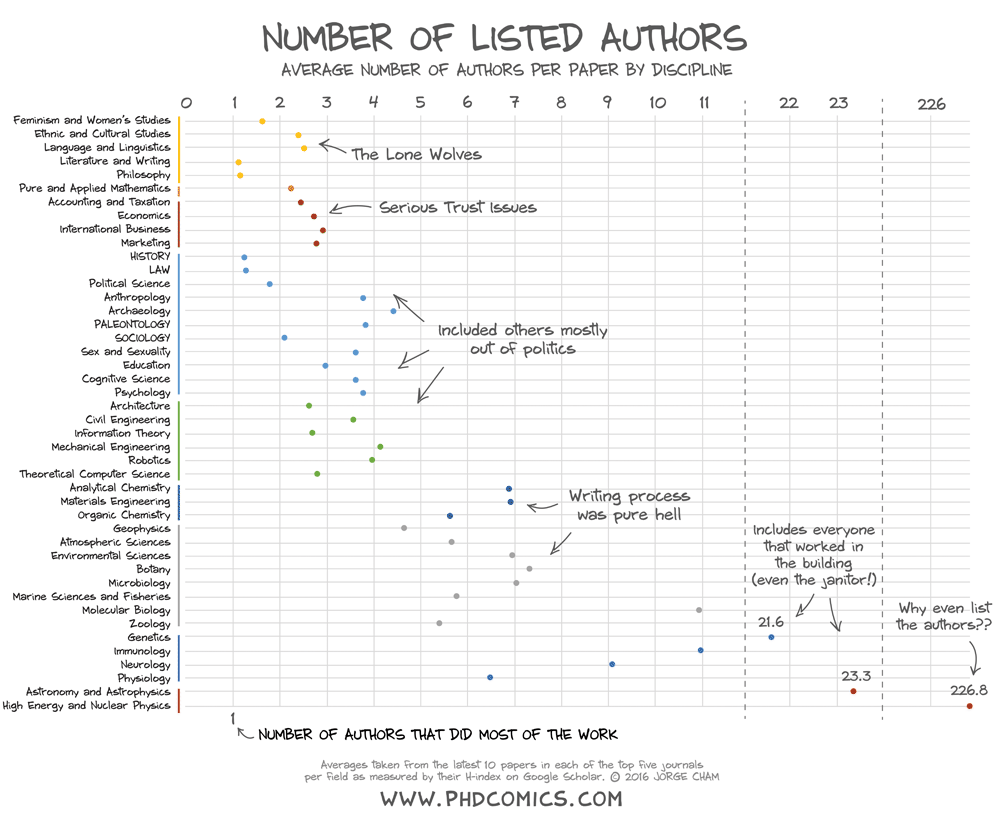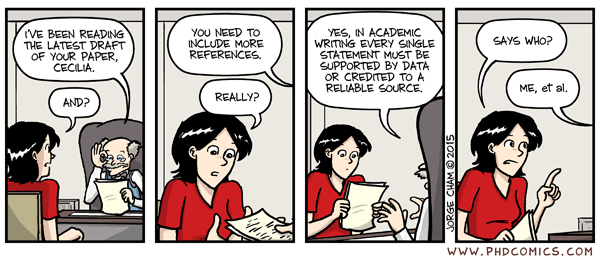This material to be used only for teaching and learning purposes by students and staff of the School of Mathematical Sciences at the University of Adelaide.
I have found in Dame Nature not indeed an unkind, but a coy Mistress: Watchful nights, anxious days, slender meals, and endless labours, must be the lot of all who pursue her, through her labyrinths and meanders. (Alexander Pope, 1741)The university has various online induction courses for research students. Here we aim to complement, with overlap, by discussing issues in the context of mathematics and statistics.
- Advice to a young mathematician (in Princeton companion to mathematics) The most important thing that a young mathematician needs to learn is of course mathematics. However, it can also be very valuable to learn from the experiences of other mathematicians.
- Ten Things I Learned During My Ph.D. Thesis Sam Relton discusses his experience as a Ph.D. student in numerical linear algebra at the University of Manchester---we later discuss many of these ten.
- AustMS Journal Rankings 2009 Its original purpose was to guide academics for the ERA. But now useful for you: seek to publish in suitable journals in the A*, A or B categories; C if appropriate; avoid others unless...
The geometers and the topologists generally all bring their families and have lots of parties and often stay longer than they intended. The algebraists are very precise, often come alone, without their families, on precisely the day they said they would three years previously. And the analysts are totally unreliable. They say they'll bring their families and then they turn up with their mistresses, and never come on the days they said they would. (Christopher Zeeman (Wolpert and Richards, 1988))
Project, seminar and paper assessment: criteria, components, and aims
- Mathematics honours Grade Descriptors, 2015
- Mathematics honours research project rubric, 2011
- Honours Presentation Assessment 2010
- Is the scientific paper a fraud? Sir Peter Medawar
- How to Read and Understand a Paper Nick Higham advises inexperienced researchers on how to go about reading mathematics research papers.
- The difficulties of getting a research paper published Associate Professor David Pannell from the University of Western Australia describes the frustrations he has experienced when attempting to have a research paper accepted by a scientific journal.
Code of Conduct for research
- The song Lobachevsky by Tom Lehrer entertains us with some 'research advice' for his paper "Analytical and algebraic topology of locally Euclidean metrization of infinitely differentiable Riemannian manifold".
- Mathematical trivium: Erdos number the website for the Erdos Number Project, which studies research collaboration among mathematicians.
- Research Integrity @ University of Adelaide Integrity is a concept of perceived consistency of actions, values, methods, measures, principles, expectations and outcomes. Responsible research is encouraged and guided by the research culture of the University of Adelaide. Faculty Research Integrity Advisers can be approached in confidence to advise a staff member, student or affiliate who is unsure about a research conduct issue and ...
- Australian Code for the Responsible Conduct of Research The Code was jointly developed by the National Health and Medical Research Council (NHMRC), the Australian Research Council (ARC) and Universities Australia. The Code has broad relevance across all research disciplines.
- Overview the code for beginning research students (albeit the code was revised in 2018).
- Reproducible Research in the Mathematical Sciences David Donoho and Victoria Stodden discuss that as the mathematical sciences evolve towards ever-heavier reliance on computation, mathematicians should likewise develop a discipline for documenting and sharing algorithms and empirical mathematical findings.
-
Do as you would be done by
`Harassment' is rarely black and white, usually shades of grey.
If a behaviour offends, then tell the perpetrator; lodge complaint after subsequent offenses.
I am at a meeting, emphasising a point by wagging my finger. A colleague tells me not to: what do I do? Answer: accept that they are affected by the wagging finger, even though I cannot see why, and desist.
- As far as I understand thinktanks.... Ben Goldacre writes a great blog about Bad Science, including this one: "It is with deep regret that I must alert you to a frightening decline in the quality of maths in reports complaining about the frightening decline in the quality of maths in Britain".
Intellectual property, copyright and ethics
- UoA Intellectual Property Policy Within an environment in which ideas are often freely shared, this Policy aims to ensure that, where desirable, the University captures and harnesses the value of its intellectual property (IP).
-
PhD comic: average number of listed authors per paper by discipline

- Unwanted Inclusion as Co-Author of Paper
- Authorship is an important issue, and the generic university training appears adequate for the Mathematical Sciences.
- Dividing Line Between "Fair Use" and Plagiarism?
- It's My Invention; Shouldn't My Name Go on Patent Application?
-
Expanding conference papers for future submission to journals It is increasingly common for MODSIM authors to expand their conference papers to journal submissions post the conference. A number of special journal issues emerge from MODSIM conferences leveraging the original MODSIM paper. Emerging journal policies with regard to earlier conference publication has led us to develop MSSANZ guidelines to build author awareness, and to provide suggested strategies for our science community.
For example, publish the symmetric matrix case in proceedings, and the general matrix case in a journal.
- Potential, possible, or probable predatory scholarly open-access publishers This is a list of questionable, scholarly open-access publishers. We recommend that scholars read the available reviews, assessments and descriptions provided here, and then decide for themselves whether they want to submit articles, serve as editors or on editorial boards. Wikipedia has useful discussion.
- Your genetic data can be exploited without you ever knowing about it William Weld, assured the public that the records would be stripped of personally identifiable information. Then he fell ill, visited a hospital, and a computer science graduate student at the Massachusetts Institute of Technology took the opportunity to show him how easily identifiable his own records were.
- A clean slate Mistakes are part of science. But setting the record straight promptly and clearly can help to avoid a career blot.
- How Prevalent Is Fraud? In 2000, a USA "federal watchdog agency to announce a $1 million grants program to investigate the prevalence of fraud, data fabrication, plagiarism, and other questionable practices in science. "
- On fact and fraud: cautionary tales from the front lines of science by David Goodstein. "Fraud in science is not as easy to identify as one might think.... On Fact and Fraud looks at actual cases in which fraud was committed or alleged, explaining what constitutes scientific misconduct and what doesn't, and providing readers with the ethical foundations needed to discern and avoid fraud wherever it may arise."
- The most common sin is simply ignoring the work of others The scientific method is not only evidence based but also to build on the work of others. You must try to learn what has been done and is being done. Use at least Google Scholar, and Google Scholar Alerts (not just Google). You must aim to read one research article per week, and relate it to your project(s). Your supervisors must help in this process.
Writing scientific english: mathematics, sentences, paragraphs, evidence
Vague and insignificant forms of speech, and abuse of language, have so long passed for mysteries of science; and hard and misapplied words, with little or no meaning, have, by prescription, such a right to be mistaken for deep learning and height of speculation, that it will not be easy to persuade either those who speak or those who hear them, that they are but the covers of ignorance, and hindrance of true knowledge. (John Locke, Essay concerning Human Understanding, 1690)
-
The style files compendium. Many technical articles I read as an editor are boringly turgid. We and our students must do better.
Some claim that such rules do not matter:
... the rules do matter; it's just that obeying them doesn't. They need to be there to create a tension between conservatism and innovation. If the innovation continued unchecked, ..., then the language would fragment into thousands of mutually incomprehensible dialects. (David Mitchell, C2010)
- Use the Hemingway Editor to avoid some of the common gross errors endemic in scientific writing.
- How to Write Mathematics by Paul Halmos. "This is a subjective essay, and its title is misleading; a more honest title might be How I Write Mathematics. It started with a committee of the American Mathematical Society, on which I served for a brief time, but it quickly became a private project that ran away with me."
- Handbook of writing for the mathematical sciences The subject of mathematical writing has been infused with life once again by Nick Higham as he follows up his successful HWMS volume with this much-anticipated second edition.
-
Elements of style by William Strunk, Jr.
Asserting that one must first know the rules before breaking them, this classic reference book is a must-have for any student and conscientious writer.
if you don't scrutinize yourself carefully, and you really think that you are just objectively depicting the world, then you are self-deluding. (Stephen Jay Gould (Wolpert and Richards, 1988))
- How well do you inform? Thomas P. Johnson, IEEE Trans. Profess. Comm. PC-25, 5-9 (1982) (pdf, 1608 KB): technical writing, communication, handling details, handling ideas, concrete nouns, active verbs, test.
- Creative Obfuscation J. Scott Armstrong, IEEE Trans. on Profess. Comm. PC-25, pp. 30-32 (1982) (pdf, 750 KB): technical writing, communication, communication for knowledge, fog index, clarity, obfuscation, unintelligibilty, journal reviewer. A rational and popular viewpoint is that the functions of scientific writing is to communicate knowledge. A study of prominent journals, however, suggests that clear communication is not appreciated within the reading-writing-refereeing community. If clarity is a goal for a journal, the editor must take action.
-
Clarify your work versus your description of established work.
Use citations and cross-references...

- Mathematical Writing Timothy Gowers gives a short and vaguer advice on writing for mathematicians---more a purish perpective.
- George Orwell: Politics and the English Language Most people who bother with the matter at all would admit that the English language is in a bad way, but it is generally assumed that we cannot by conscious action do anything about it.
- The Chicago Manual of Style Online
- Practical Criticism, I.A. Richards (1929)
The only proper attitude is to look upon a successful interpretation, a correct understanding, as a triumph against the odds. We must cease to regard a misinterpretation as a mere unlucky accident. We must treat it as the normal and probable event.
- Mathematics: An Experimental Science In mathematical research now, there's a very clear path of that kind. It begins with wondering what a particular situation looks like in detail; it continues with some computer experiments to show the structure of that situation for a selection of small values of the parameters of the problem; and then comes the human part: the mathematician gazes at the computer output, attempting to see and to codify some patterns.
Materials and data management, computer tools
- Essential: every document needs a title, author(s), and date. This is fundamental professional document management. Even working notes should be dated. Further, everybody who (co-)authors a research publication or dissertation must go to https://orcid.org and register to get an ORC-ID. It provides a persistent digital identifier that distinguishes you from every other researcher. It is yours to own and control for life over changing addresses and names. Use your ORC-ID as part of your address on all professional publications.
- NIH Strategic Plan for Data Science "Storing, managing, standardizing and publishing the vast amounts of data produced by biomedical research is a critical mission for the National Institutes of Health. [... This 2018 document] provides a roadmap for modernizing the NIH-funded biomedical data science ecosystem" despite ...
-
Essential: keep at least three copies in at least two well-separated physical places Perhaps:
- home computer, work computer, memory stick to carry between; or
- laptop to transport, home backup, work backup.
- The University's Post-Graduate Centre gives workshops on generic management of data and primary materials. For example, LabArchives is a University-wide Electronic Research Notebook solution that can improve quality, collaboration, accessibility, searchability, security and efficiency when capturing research data.
- Research Compliance: Lost Data in one of my checked bags was my notebook computer and three discs of raw data (non-encrypted) on about 800 patients we have enrolled in a clinical trial. But the airline lost the bag in transit.
- Digital doomsday: the end of knowledge by Tom Simonite and Michael Le Page, New Scientist, 2010. Yet even as we are acquiring ever more extraordinary knowledge, we are storing it in ever more fragile and ephemeral forms. If our civilisation runs into trouble, like all others before it, how much would survive?
- Best Practices for Scientific Computing Scientists spend an increasing amount of time building and using software. However, most scientists are never taught how to do this efficiently. As a result, many are unaware of tools and practices that would allow them to write more reliable and maintainable code with less effort. We describe a set of best practices for scientific software development that have solid foundations in research and experience, and that improve scientists’ productivity and the reliability of their software.
- Having created some potentially useful computer
script, how do you make it publicly available?
- The university has a repository: figshare is an online digital repository where researchers can preserve and share their research outputs, including figures, datasets, images, videos, and code.
- Make code public on a site like Github or gitlab.
- RunMyCode is a free web service specifically for academics to make code available.
- Software capentry provide open access teaching materials
- Introduction to programming (python) This website teaches computer programming.
Professional presentations
- How to Start a Speech: tell a story.
- Dr Fox presents by Naftulin, Ware, and Donnelly, Journal of Medical Education, vol. 48, pp. 630--635, 1973. Dr. Fox was an actor. He looked distinguished and sounded authoritative. A questionnaire administered after the talk indicated that the audience found Dr. Fox's lecture to be clear and stimulating. None of the subjects realized that the lecture was pure nonsense.
- Simple `beamer' template for presentations
- The Short Talk by Charles Van Loan. The short talk (<= 20 minutes) is a fixture at most scientific conferences. Assuming that you are using slides, this note focuses on how to give a good short talk.
- TED Talks: the Official TED Guide to Public Speaking (2016) written by Chris Anderson, Head of TED, explains "how the miracle of powerful public speaking is achieved, and to equip you to give it your best shot. But one thing needs emphasizing right at the start. There is no one way to give a great talk."
- 10 Tips for Handling Inquiries, Interviews at some point in your career a reporter may call or your institution may ask you to speak to the media.
- How and Why to Ask Good Questions during Interviews the typical interview for a PhD-level position lasts a full day or more, including a one-hour seminar and one-on-one meetings with researchers and/or faculty as well as managers/administrators. The one-on-one meetings are expected to be two-way conversations; unfortunately, candidates don’t always realize this.
- The Academic Job Interview The Academic Job Talk; The Research Presentation; 3 Questions To Expect, To Ask, And To Not Ask During Your Campus Visit
LaTeX: separate logical composition from physical layout
Mostly you have written documents to markers who already know all the answers. Now you are entering a life where you are to write documents where readers have to comprehend/learn something that they did not previously know. This new life requires better writing and typesetting.- Example research methodology establishes best typography Colin Wheildon used comprehension to subject typographic maxims to scientific research.
- Instructional typographies using desktop publishing techniques to produce effective learning and training materials by Wendy Priestly, Australian Journal of Educational Technology 1991, 7(2), 153-163.
-
Scenario: you work for a company that needs to publish a document admitting to embarrassing facts, but wishes to obfuscate those facts as far as possible.
Typesetting helps obfuscate the content:
- use a sans serif font such as Arial;
- make the line width as wide as possible across the page;
- typeset lines ragged left such as centred or only right justified;
- colour the text some attractive non-black colour;
- include a patterned background, especially with components similar in colour to the text;
- interrupt reading with graphics in the middle of pages (online: especially if it blinks or moves);
- use gratuitous bold for innocuous statements to misdirect focus.
- LaTeX: a quick start to style and finesse LaTeX is arguably the premier typesetting package in the world. Knuth and Lamport have distilled for us the accumulated wisdom of generations of printers.
- LaTeX2e reference (162k,html)
Write 'grant' applications
- Five Common Mistakes That Will Sink Your Grant The challenge that all reviewers face as they try to separate the outstanding from the merely good is to convert their intuitive, emotional response to a grant into a series of bullet points that encapsulate the proposal's strengths and weaknesses. Avoiding these pitfalls, and appreciating the issues that frequently diminish reviewer enthusiasm, should help you to write a better grant.
- Does Your Location Influence Your Grant's Funding Chances But this is an imperfect world
- When Re-Submitting a Rejected Grant? My grant was rejected, not because the experiments were flawed but because the topic didn't "click" with some study section reviewers.
If you like this web page, please link to it so others can find it more easily.


